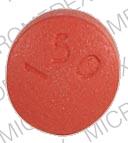Rifapentine Disease Interactions
There are 3 disease interactions with rifapentine.
Antibiotics (applies to rifapentine) colitis
Major Potential Hazard, Moderate plausibility. Applicable conditions: Colitis/Enteritis (Noninfectious)
Clostridioides difficile-associated diarrhea (CDAD), formerly pseudomembranous colitis, has been reported with almost all antibacterial drugs and may range from mild diarrhea to fatal colitis. The most common culprits include clindamycin and lincomycin. Antibacterial therapy alters the normal flora of the colon, leading to overgrowth of C difficile, whose toxins A and B contribute to CDAD development. Morbidity and mortality are increased with hypertoxin-producing strains of C difficile; these infections can be resistant to antimicrobial therapy and may require colectomy. CDAD must be considered in all patients who present with diarrhea after antibacterial use. Since CDAD has been reported to occur more than 2 months after antibacterial use, careful medical history is necessary. Therapy with broad-spectrum antibacterials and other agents with significant antibacterial activity should be administered cautiously in patients with history of gastrointestinal disease, particularly colitis; pseudomembranous colitis (generally characterized by severe, persistent diarrhea and severe abdominal cramps, and sometimes associated with the passage of blood and mucus), if it occurs, may be more severe in these patients and may be associated with flares in underlying disease activity. Antibacterial drugs not directed against C difficile may need to be stopped if CDAD is suspected or confirmed. Appropriate fluid and electrolyte management, protein supplementation, antibacterial treatment of C difficile, and surgical evaluation should be started as clinically indicated.
References
- "Product Information. Omnipen (ampicillin)." Wyeth-Ayerst Laboratories PROD (2002):
- "Product Information. Ceftin (cefuroxime)." Glaxo Wellcome PROD (2002):
- "Product Information. Zinacef (cefuroxime)." Glaxo Wellcome PROD (2002):
- "Product Information. Cleocin (clindamycin)." Pharmacia and Upjohn PROD (2002):
- "Product Information. Macrobid (nitrofurantoin)." Procter and Gamble Pharmaceuticals PROD (2002):
- "Product Information. Macrodantin (nitrofurantoin)." Procter and Gamble Pharmaceuticals PROD (2002):
- "Product Information. Amoxil (amoxicillin)." SmithKline Beecham PROD (2001):
- "Product Information. Merrem (meropenem)." Astra-Zeneca Pharmaceuticals PROD (2001):
- "Product Information. Coly-Mycin M Parenteral (colistimethate)." Parke-Davis PROD (2001):
- "Product Information. Lincocin (lincomycin)." Pharmacia and Upjohn PROD (2001):
- "Product Information. Cubicin (daptomycin)." Cubist Pharmaceuticals Inc (2003):
- "Product Information. Xifaxan (rifaximin)." Salix Pharmaceuticals (2004):
- "Product Information. Doribax (doripenem)." Ortho McNeil Pharmaceutical (2007):
- "Product Information. Penicillin G Procaine (procaine penicillin)." Monarch Pharmaceuticals Inc (2009):
- "Product Information. Vibativ (telavancin)." Theravance Inc (2009):
- "Product Information. Teflaro (ceftaroline)." Forest Pharmaceuticals (2010):
- "Product Information. Penicillin G Sodium (penicillin G sodium)." Sandoz Inc (2022):
- "Product Information. Dalvance (dalbavancin)." Durata Therapeutics, Inc. (2014):
- "Product Information. Orbactiv (oritavancin)." The Medicines Company (2014):
- "Product Information. Bicillin C-R (benzathine penicillin-procaine penicillin)." A-S Medication Solutions (2017):
- "Product Information. Baxdela (delafloxacin)." Melinta Therapeutics, Inc. (2017):
- "Product Information. Polymyxin B Sulfate (polymyxin B sulfate)." AuroMedics Pharma LLC (2022):
- "Product Information. Zemdri (plazomicin)." Achaogen (2018):
- "Product Information. Seysara (sarecycline)." Allergan Inc (2018):
- "Product Information. Nuzyra (omadacycline)." Paratek Pharmaceuticals, Inc. (2018):
- "Product Information. Aemcolo (rifamycin)." Aries Pharmaceuticals, Inc. (2018):
- "Product Information. Fetroja (cefiderocol)." Shionogi USA Inc (2019):
- "Product Information. Biaxin (clarithromycin)." AbbVie US LLC SUPPL-61 (2019):
- "Product Information. Zithromax (azithromycin)." Pfizer U.S. Pharmaceuticals Group LAB-0372-7.0 (2021):
- "Product Information. E.E.S.-400 Filmtab (erythromycin)." Arbor Pharmaceuticals SUPPL-74 (2018):
- "Product Information. Priftin (rifapentine)." sanofi-aventis SUPPL-18 (2020):
- "Product Information. Xerava (eravacycline)." Tetraphase Pharmaceuticals, Inc (2021):
- "Product Information. Xacduro (durlobactam-sulbactam)." La Jolla Pharmaceutical ORIG-1 (2023):
- "Product Information. Exblifep (cefepime-enmetazobactam)." Allecra Therapeutics ORIG-1 (2024):
- "Product Information. Maxipime (cefepime)." Hospira Inc SUPPL-46 (2021):
Rifapentine (applies to rifapentine) liver disease
Moderate Potential Hazard, Moderate plausibility.
Although the single-dose pharmacokinetic profiles of rifapentine and its active metabolite, 25-desacetyl rifapentine, were similar in patients with various degrees of liver dysfunction and to those observed in healthy subjects, therapy with rifapentine should be administered cautiously in such patients, since the drug is primarily eliminated by the liver. Patients with abnormal liver tests and/or liver disease should only be given rifapentine in cases of necessity and under strict medical supervision; serum transaminase levels should be obtained before therapy and every 2 to 4 weeks during therapy. Rifapentine should be discontinued if liver injury occurs.
References
- "Product Information. Priftin (rifapentine)." sanofi-aventis SUPPL-18 (2020):
Rifapentine (applies to rifapentine) porphyria
Moderate Potential Hazard, Moderate plausibility.
Rifapentine should be avoided in patients with porphyria. Porphyria has been reported with rifampin, attributed to induction of delta amino levulinic acid synthetase; rifapentine may have similar enzyme induction properties.
References
- "Product Information. Priftin (rifapentine)." sanofi-aventis SUPPL-18 (2020):
Rifapentine drug interactions
There are 464 drug interactions with rifapentine.
Rifapentine alcohol/food interactions
There is 1 alcohol/food interaction with rifapentine.
More about rifapentine
- rifapentine consumer information
- Check interactions
- Compare alternatives
- Side effects
- Dosage information
- During pregnancy
- Drug class: rifamycin derivatives
- Breastfeeding
- En español
Related treatment guides
Drug Interaction Classification
| Highly clinically significant. Avoid combinations; the risk of the interaction outweighs the benefit. | |
| Moderately clinically significant. Usually avoid combinations; use it only under special circumstances. | |
| Minimally clinically significant. Minimize risk; assess risk and consider an alternative drug, take steps to circumvent the interaction risk and/or institute a monitoring plan. | |
| No interaction information available. |
Further information
Always consult your healthcare provider to ensure the information displayed on this page applies to your personal circumstances.


